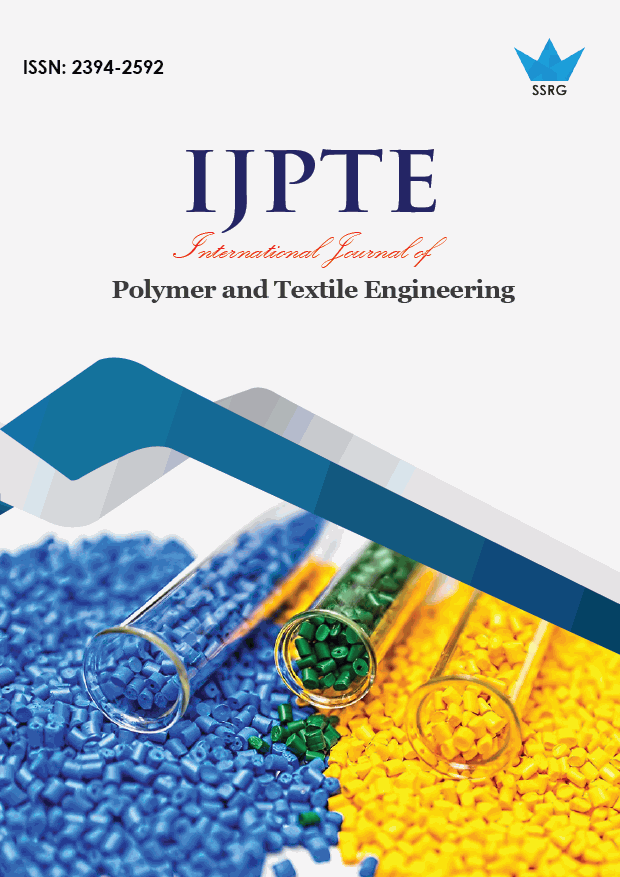Artistic Finishes for Home Textile Materials

| International Journal of Polymer and Textile Engineering |
| © 2017 by SSRG - IJPTE Journal |
| Volume 4 Issue 2 |
| Year of Publication : 2017 |
| Authors : Alessandro, Caseareo |
How to Cite?
Alessandro, Caseareo, "Artistic Finishes for Home Textile Materials," SSRG International Journal of Polymer and Textile Engineering, vol. 4, no. 2, pp. 1-4, 2017. Crossref, https://doi.org/10.14445/23942592/IJPTE-V4I2P101
Abstract:
Fragrance ultimate of textile materials has been greatly lengthened and used in recent years. Fragrance destroying can be done effectively using exhaust method than any other methods. If the fabric is treated with fragrance agents which exhibitions higher durability of functionality is estimated. Fragrance destroying can be done by means of lavender aroma with non-ionic binder. This paper observes the effects of fragrance finished aloe-vera and cotton fabrics. Lastly both the fragranced completed fabrics were made into wall hangings and the environment of the room was estimated by comparing various factors. In this exploration, factors such as fabric performance, stability of the fragrance and laundering properties of the treated fabrics were considered. The fragrance finished fabrics can be used in home textile submissions such as wall hangings, table covers, carpets and sofa covers.
Keywords:
Fragrance Finishes, Cotton Fabric, Aloe-Vera Fabric, Lavender.
References:
[1] Matsushi-Shikiso Chemical Co. Ltd. “Fixing Odorous to Textiles. High-Per- formance-Textile”. 1994(8): No author, 2000.
[2] Mendapara, S. and Karolia, A. (2005). “Application of Antimicrobial and Fragrance Finish in Combination by Microencapsulation on Cotton Fabric”, Journal of the Textile Association, 66(4): 155–159.
[3] Buchbauer, G. 1993. “Fragrance compounds and essential oils with sedative effects upon inhalation”, American Pharmaceutical Association. 52, 560-664.
[4] John Pierce, leader; Fernando Tovia; Natalie Weathers (Phila U) “Scent-Infused Textiles to Enhance Consumer Experiences” National Textile Center Research Briefs – Fabrication Competency: June 2006.
[5] B. Martel “Capture and Controlled Release of Fragrances by CD Finished Textiles”, Journal of Inclusion Phenomena and Macrocyclic Chemistry 44: 439–442, 2002.
[6] KrzyszGniotek, “Odor Measurement in Textile Industries – Fibres & Textiles” in Eastern Europe January / March 2003 Vol. 11 No.1 (40)
[7] Sina D. Escher a, and Esther Oliveros b “A Quantitative Study of Factors That Influence the Substantivity of Fragrance Chemicals on Laundered and Dried Fabrics”.
[8] Buchbauer, G. Aromatherapy: “Use of fragrance and essential oils as medicaments”. Flavor and Fragrance Journal. 9, 217-222: 7-8.
[9] Landau, P. Kline “Study shoes double-digit growth for home fragrance”. Chemical Market Reporter. 1999, 256(9):18.
[10] Buschmann, H-J. “Resin Finishing of Cotton in the Presence of Cyclodextrins for Depostiting Fragrance”. MelliandTextilberchite, 1991(3).

 10.14445/23942592/IJPTE-V4I2P101
10.14445/23942592/IJPTE-V4I2P101